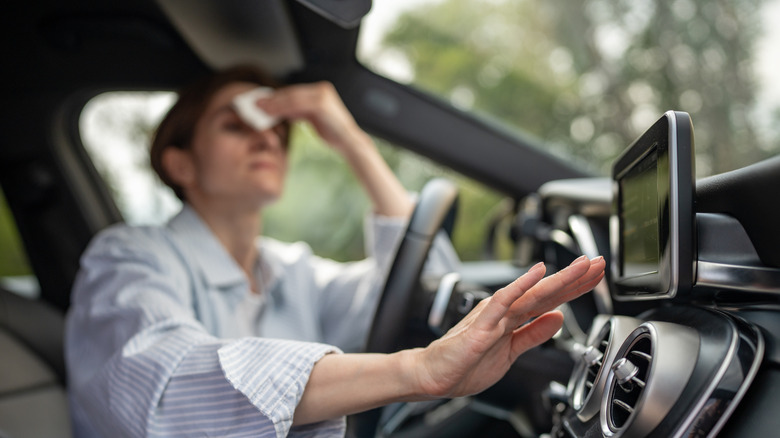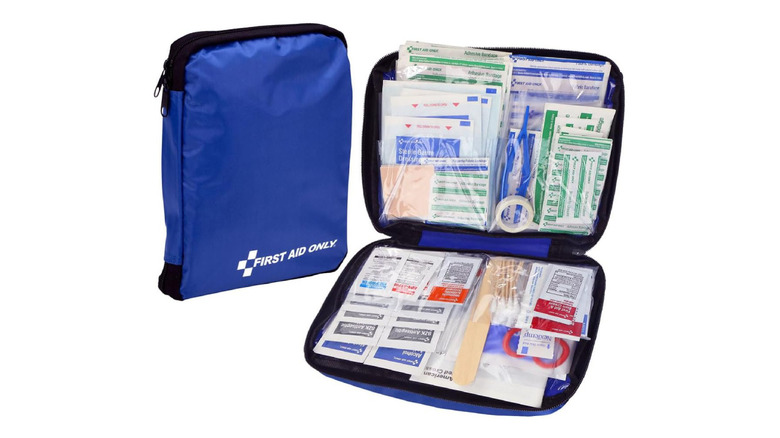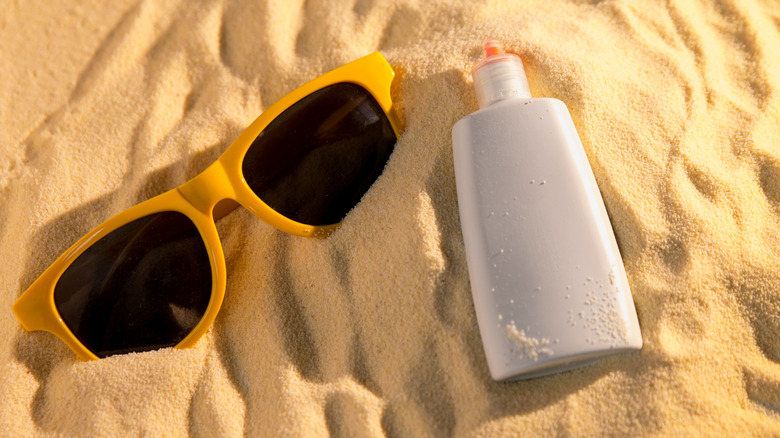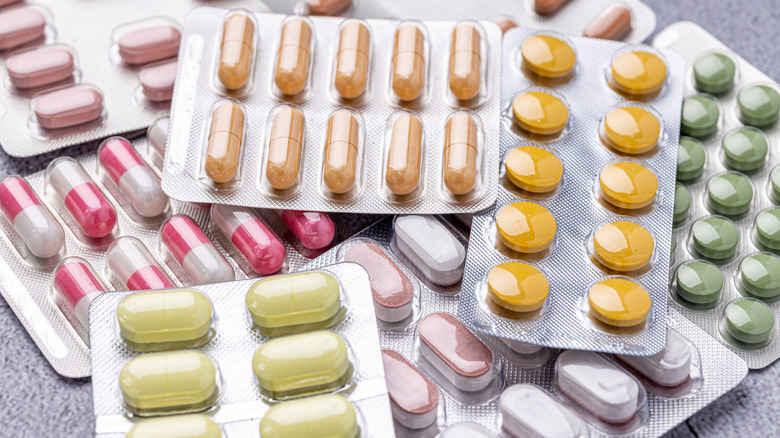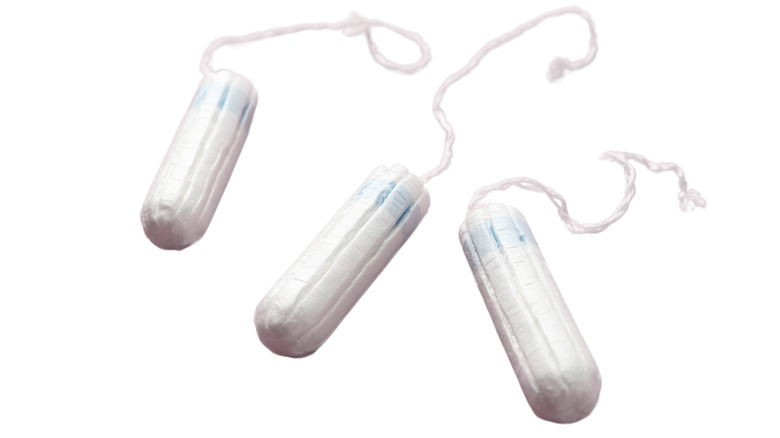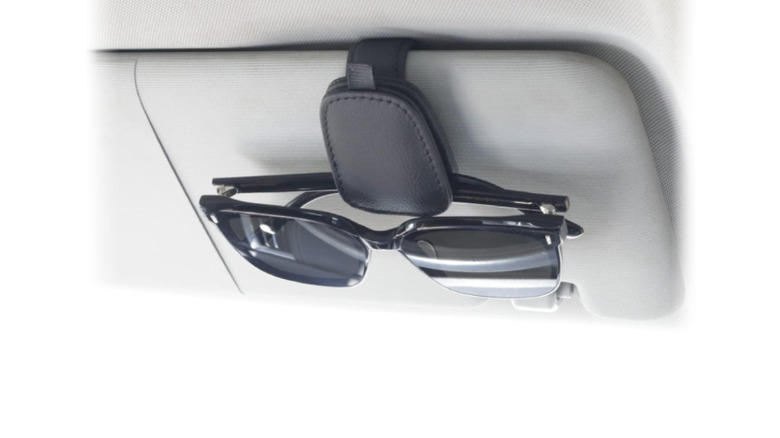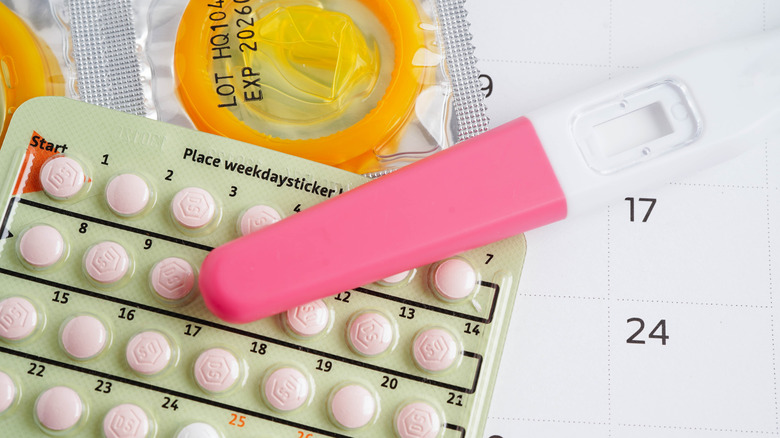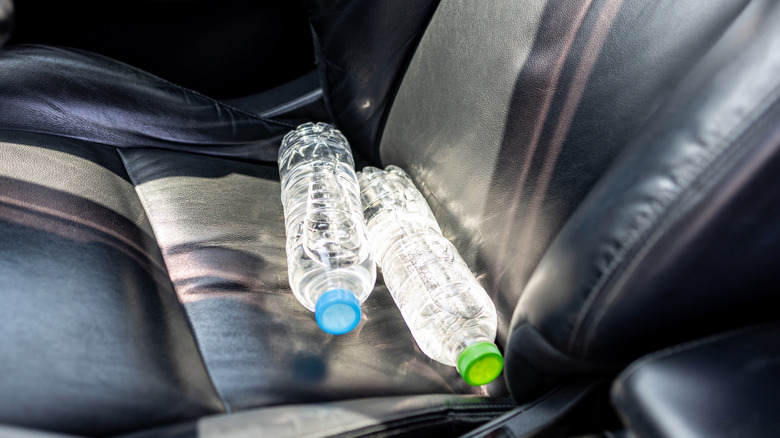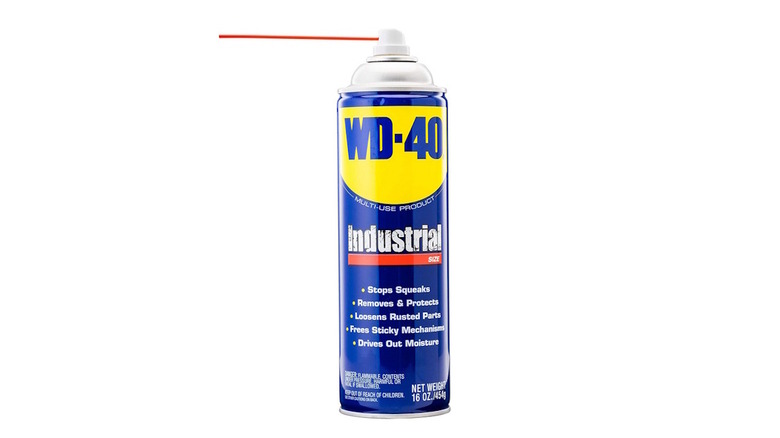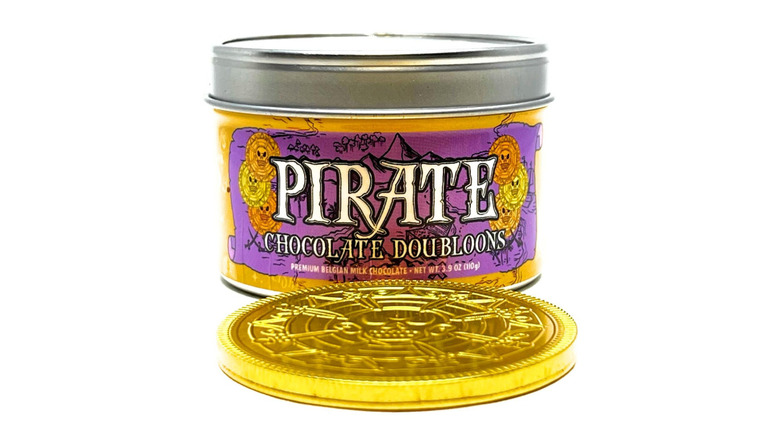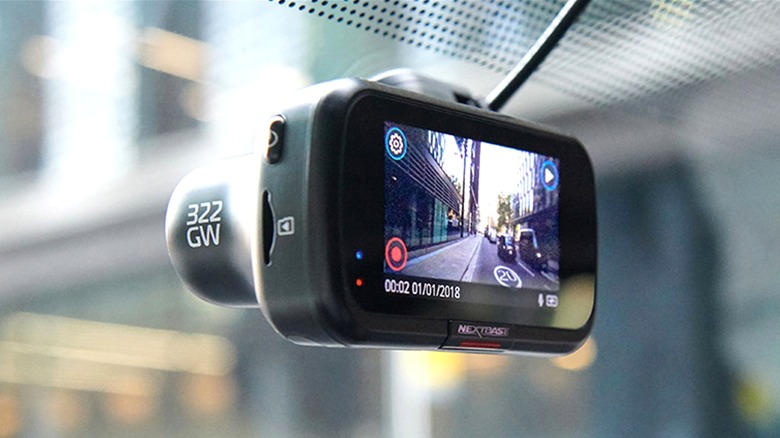10 Things You Should Avoid Leaving In Your Car In Hot Temperatures
We may receive a commission on purchases made from links.
It's a hot day. The car's thermometer says 95°F but you know the humidity is skyrocketing, too. You park the car in the first spot you find, shade or no shade. You can't wait to get out of this metal box that's slowly turning into an oven. You glance at the back seat. Good, there's nothing important there. Just some cheap gadgets for the 12V outlet no one will bother stealing and the water bottle you keep for a quick swig or two. You made sure the engine is ready to withstand the heat, and while getting back in the car tomorrow isn't going to be fun, you can't stand to be here one more minute. You'll find a better parking spot tomorrow.
And yet, though we wish it weren't true, your job is not done here. Those electronics, especially the cheap ones, aren't safe inside that hot car. Assuming you want to use them again, that is. The water bottle? Besides possibly poisoning the liquid inside, if it's left under direct sunlight, it might start a fire. We don't take any joy in saying this, but you should probably pick a bag, get those things inside, and haul them home, where they'll be a little cooler. And that goes for a lot more than gadgets and water bottles. But don't worry — making sure your belongings (and your car) are safe during intense heat is easy, once you know which things you should avoid leaving in your car in hot temperatures.
First aid kit
Having a first aid kit in your car is an excellent idea, but making sure it is operational when needed isn't always easy. One of the worst enemies of first aid kits are extreme temperatures, both cold and hot. Not everything suffers equally under hot temperatures, but it's best to keep your car's first aid kit insulated and cool. There are two important aspects to making sure they remain useful in all conditions. First, you want to stuff the kit with things that don't suffer as much under heat. For example, some bandages hold up against heat better than others. Then, you should put those tools and medicines in a durable, water and heat-resistant case.
Making a heat-resistant first aid kit might mean building one yourself instead of using a pre-packaged one. At this point, though, your car might be getting a little crowded. After all, a first aid kit isn't the only emergency tool you should always keep in your car. Maybe you'd be better served by getting a trusted first aid kit that has all the essentials and then put anything perishable, like epi-pens and medicine, in a separate, heat-resistant container somewhere where it will never see direct sunlight. A neat trick to better insulate a container in a pinch is to fill the empty space with sealed water bottles. Water takes a long time to heat up (certainly more than air) so switching one for the other effectively adds insulation.
Sunscreen
It might be unintuitive, but your sunscreen needs protection, too, especially during hot and sunny days. Ironically, sunlight is the worst enemy of sunscreen. And no, you can't sunscreen the bottle. The problem isn't the rays of light themselves, but the heat. Of course, where there is one there is usually the other, but that means that the inside of your car, including areas protected by light like the glove box, the trunk, or even a handbag, are not safe for your sun cream. This lotion is often as sensitive as any medicine. At the end of the day, most sunscreen is just a chemical compound, and it degrades when continuously exposed to heat higher than 77°.
So, should you keep sunscreen inside a fridge? Probably not. Unless you have a dedicated cosmetics mini-fridge (or any kind of adjustable mini-fridge, really), the extreme cold can be just as bad for sunscreen as the heat. Ultimately, you should follow the instructions on the box. However, when you need to bring it along with you, it might be a good idea to stuff it in an insulated cooler bag. Those don't exactly reach freezing temperatures, and chances are, you already have one. It's one of the most popular gadget to keep you cool.
Medicine
"Heat and medication don't mix", reads an article penned by Baylor College of Medicine doctors and published by the same institution. Of course, not every medication will be made ineffective by extreme heat, or at least not the kind of heat you can find in a parked car. Saline solution, for one, is very resilient to high and even extreme heat. On the other hand, epinephrine injectors and insulin are potentially life-saving medicine, and both are known to be especially sensitive to heat. While a few hours in the sun won't spoil them, they might become ineffective after just a few days in a scorching hot car.
So, how do we deal with this? The obvious solution is to avoid storing medicine in your car. That might be as simple as moving the blister from the glove box to a bag you always carry with you, but you might have good reasons to keep medicine in your car. If that's the case, then make sure that you're only storing medicine that is at least somewhat resistant to heat. It might be hard to keep your car's temperature below 77°F at all times, but some drugs can be safely stored at 86°F or even higher. For them, you might be able to maintain the required temperature with just an insulated container and a sunshade.
Tampons
Heat can make tampons go bad before their expiration date, and it can be really hard to tell a good tampon from a bad one. And yes, tampons do expire, usually after five years from production. Even though most tampons aren't going to sit on a shelf for five years, if you use them at all, you should know they don't last forever. Worse still is that excessive moisture can make a tampon moldy way before its expiration date. Who keeps track of the humidity inside their car? Air, it's worth remembering, tends to be more humid in higher temperatures. That's not exactly how it works, we know, but it's true in essence.
Besides, that's not the point. The point is: Don't leave tampons in a hot car. That said, it almost certainly takes more than one or two days in a hot car to ruin an unopened pack of tampons. If you're worried about the bag you forgot in the car earlier this week, don't. If you've been doing this for a while, we have some bad news. Mold can spread through a tampon from the inside out, making it nearly impossible to tell if one has already been affected. If you're unsure if a tampon is safe and it has been stored improperly for a while, throw it out. The risk is not worth it.
Glasses
Can heat damage glasses? Of course they can. Anything plastic can be completely ruined by prolonged exposure to high temperatures. But can heat damage the lenses? Now, that's an entirely different question, and one that is much harder to answer with confidence. The first problem is that lenses are not always made of glass. Most of them are plastic, and we're not just talking about the overpriced shades you buy at a beachside stall when you realize you didn't bring any. Plastic lenses are light, more resilient, and arguably safer, since they don't break the way glass does.
Even if your lenses are made out of glass, they might have some kind of coating. Polarized glasses are one example of this, and extreme heat is known to damage the film that grants that effect. The film isn't just going to slide off your glasses if it's too hot, either. Instead, it will result in "crazing", the creation of many tiny cracks that can ruin a perfectly good pair of glasses. The solution? Find a better storage solution for your glasses. It makes sense to leave a pair of shades near the driver's seat, but many sunglass holders put them in contact with the roof of the car, and that thing gets really hot. A clip-on gadget holder that attaches to your sun visor might look like a clever solution, but that's the worst possible place for your glasses.
All kinds of contraception
Yes. Really. Heat can ruin every kind of contraception. Condoms, which are probably quite high in the list of items people purposefully leave inside their cars, are made of plastic -– latex, most of the time –- so of course they're vulnerable to heat. Sources indicate 104°F as the maximum heat condoms can endure for just a few days, and 86°F as the optimum long-term storage temperature. Cars can get much, much warmer than that, potentially ruining the effectiveness of contraceptives in less than a week.
What about birth control pills, or a contraceptive ring? Chances are, there are far fewer cars full of pills than condoms, but they're equally susceptible to heat. Actually, pills and rings are even more sensitive. As with almost all medicine, they should be discarded if they're stored at a high enough temperature (sometimes as low as 68°F) for a few days or longer. Not only can their effectiveness be compromised, but they might make you sick as well. Thankfully, there's a simple solution to this problem — don't leave contraceptives inside your car when it's really hot.
Plastic water bottles
We said only a minute ago that you can use plastic water bottles to insulate a container too large for its contents, and now we're saying they're dangerous? It's complicated, but the first thing you should know is that plastic bottles can cause a fire. Sure, it's very unlikely to happen, and the water bottle isn't going to catch fire directly, as funny as that would be. To do that, it would have to reach 400°F, and then the fire would have to deal with the water inside. However, if left under direct sunlight, that same bottle can act like a magnifying glass and burn anything near it. Just to be safe, make sure to store full bottles where they're protected, like in the trunk or in a bag.
Even if that bottle didn't deal with your car like a mean kid with a magnifying glass, that doesn't mean it's safe to drink, no matter how much you enjoy the taste of 80°F water in the summer. A common water bottle, sealed or not, could be contaminated with traces of chemicals from the plastic if it's stored at extreme temperatures. Not everyone agrees this is dangerous, but at least one study found that extreme circumstances (4 weeks at 158°F) can load the water with unsafe levels of a chemical called antimony. But even if that wasn't the case, warm water is extremely good at fostering the bacteria found in a reused bottle. The solution? Get a reusable, non-plastic water bottle and wash it often.
Aerosol cans
Aerosol cans, or spray cans, are pressurized containers. The pressurized gas they contain, as all gasses do, wants to take up more space and expand. When an opening is created in the can, like when the mechanism is activated and the valve is opened, the gas pushes the liquid out. As you might know, heat increases pressure in a gas, and extreme heat can lead to an increase so high that the canister can't offer enough resistance. This can cause a violent explosion, which is something you want to keep outside of your car.
But don't worry, it gets much worse. A small bottle of deodorant is probably not going to demolish your car's interiors, but what about spray paint, toxic pesticides, or a solvent like the incredibly useful (and incredibly flammable) WD-40? As you can hopefully see, different types of spray cans carry different risks. However, flammable aerosols cans are definitely more dangerous than the others. If you thought an explosion could ruin your car, think what a fire can do. Aerosol sprays might explode when exposed to ambient temperatures of just 120°F. Storing them in the trunk won't do the trick this time, and some suggest that spray cans might not belong in a car even during the cold months.
Candies and chocolate
Candies won't make your car catch fire, they won't explode, and they will (probably) not make you sick if you try to eat them after they've been stored at 100°F for a few days. Neither will a chocolate bar, lollipops, or those large gold coins that you're starting to think might not be real doubloons. All things considered, it's not outright dangerous to store candies in a hot car. However, even if it is safe, it will make you sorry.
Do you want to spend an afternoon cleaning the passenger seat? Because chocolate in a hot car will cause that. Sure, there are some car cleaning tips that can speed things up or cheap tools that make cleaning the car's inside easier, but it's still far from anyone's idea of a good day off. An ounce of prevention is worth a pound of cure. Plus, the car's seats really mess with the candy's taste.
Electronics
Let's make one thing clear: Many electronics – including your phone, desktop or laptop PC, cameras – are supposed to get hot. Using power generates heat, and some of those things use a lot of power. This argument is often used to explain why it's fine to leave electronics and digital gadgets in a hot car. However, our devices aren't supposed to stay hot for long. That's why computers and game consoles have vents — the air helps the inside of the case keep cool, so the most vulnerable components will stay within safe temperatures. If the heat is too high, most of them will turn off on their own, to preserve the hardware's integrity.
You might already know that where you work with your laptop influences its lifespan, but what if the heat isn't generated by the machine itself? You can't auto-shut down the sun, so the heat keeps rising, potentially exceeding safety levels and damaging your equipment. The most vulnerable devices are those that use a battery. Letting phone batteries get too hot is a common mistake, and it's hard to avoid in this case, too. Pretty much every useful car gadget uses a battery, including dashcams, a useful car upgrade, but one you must leave attached to the roof of the car 24/7.
